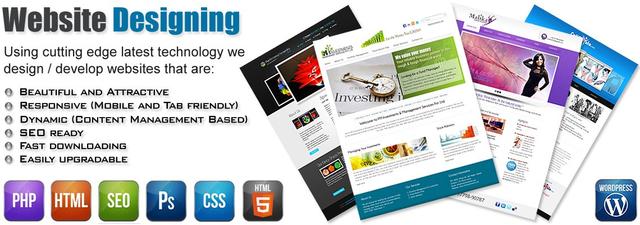A Comprehensive Guide to Responsive Website Design Methods
Responsive internet style has come to be a necessary element in the growth of digital systems, permitting a smooth user experience throughout a wide range of tools. This guide will certainly check out crucial strategies such as fluid formats, media queries, and photo optimization that add to efficient receptive style. By recognizing these principles, developers can create web sites that not only adapt aesthetically but additionally improve user involvement. Nonetheless, the landscape of website design is continuously advancing, increasing inquiries concerning the future of responsiveness and the techniques that will certainly specify it.
Recognizing Responsive Website Design
Receptive internet design (RWD) is a method that makes sure an internet site's layout and content adapt effortlessly throughout a range of tools and display dimensions (Web Design Pretoria). This design methodology is vital in today's electronic landscape, where customers access internet sites from smart devices, tablet computers, laptop computers, and computer. RWD enhances customer experience by permitting a web site to preserve performance and aesthetics, no matter the device being made use of
Additionally, media questions are utilized to apply various styles based on tool attributes like display width and positioning. This method ensures that the internet site's design is customized to the specific requirements of users, improving usability.
In addition, RWD contributes favorably to seo (SEARCH ENGINE OPTIMIZATION) by promoting a solitary, consistent URL for a website, which simplifies link sharing and indexing. As smart phone usage remains to climb, comprehending and implementing responsive website design is important for services intending to reach a wider target market and improve general internet performance.
Key Principles of Responsive Design
To produce an effective receptive layout, several key principles have to be considered. First, a mobile-first technique is vital. This means developing for the smallest screens first and gradually improving the design for larger gadgets. This method makes sure that the crucial web content is focused on and obtainable on all displays.
2nd, versatile grids and layouts are important. Utilizing a grid system that adapts to various display sizes permits a harmonious distribution of content, making certain readability and use throughout gadgets. This adaptability is complemented by the use loved one systems, such as portions or ems, as opposed to fixed pixels.

Lastly, prioritizing material pecking order is important. Logical and clear company of content improves customer experience, directing site visitors via the site flawlessly, regardless of the gadget made use of. Web Design Pretoria. By adhering to these principles, developers can produce internet sites that are not only visually attractive yet user-centered and additionally functional across all gadgets
Strategies for Fluid Layouts
Fluid designs are crucial for creating adaptive web experiences that effortlessly readjust to various screen sizes. By using percentage-based sizes rather than dealt with pixel values, designers can guarantee that aspects on a web page resize proportionally, keeping aesthetic harmony across devices. This technique promotes versatility, enabling material to adjust and move as the viewport adjustments.
One reliable approach for attaining liquid formats is to use CSS Flexbox or Grid systems. These CSS components make it possible for programmers to create receptive frameworks that can conveniently reposition and resize based upon the offered room. Flexbox excels in one-dimensional formats, while Grid is excellent for two-dimensional setups, providing better control over positioning and positioning.
An additional technique involves making use of media questions to specify breakpoints where modifications are needed - Web Design Pretoria. By specifying different designs for numerous screen sizes, designers can why not find out more change format residential or commercial properties dynamically, making sure ideal usability and visual allure
Furthermore, incorporating relative devices like ems or rapid eye movements for font sizes and spacing can even more enhance fluidness, as these devices scale based on customer settings or parent components. Together, these strategies promote the advancement of fluid formats that promote an engaging customer experience throughout diverse devices.
Maximizing Images for All Instruments
Pictures play a vital role in web layout, and enhancing them for various devices is essential for boosting performance and customer experience. To achieve this, developers ought to use responsive photo methods that make certain pictures present correctly throughout various screen dimensions and resolutions.
One effective approach is using the HTML" aspect, which enables specifying anchor numerous image resources based upon the display conditions. By using 'srcset' qualities, developers can offer various picture resolutions, enabling the web browser to select the most proper one for the customer's device.
Furthermore, implementing appropriate documents formats is important. Styles such as JPEG, PNG, and WebP each offer distinct purposes and can substantially influence loading times. WebP, as an example, uses premium compression, leading to smaller data sizes without compromising top quality.
Another crucial element is picture compression. Devices like TinyPNG or ImageOptim can lower documents dimensions, improving loading speed while preserving visual integrity. Additionally, utilizing CSS for history pictures can enhance packing as they can be controlled a lot more fluidly throughout tools.
Eventually, enhancing pictures not only enhances site performance however additionally adds to far better individual interaction and retention, making it an essential method in responsive website design.
Keeping and examining Responsiveness
Ensuring a seamless user experience across various tools calls for attentive screening and maintenance of responsiveness. The very first step in this procedure is to use a combination of manual and automated testing devices. Tools such as Google's Mobile-Friendly Test and BrowserStack enable programmers to sneak peek exactly how their web sites carry out throughout numerous gadgets and display dimensions efficiently.
Additionally, it is vital to do regular audits of your website's design and functionality. This includes monitoring for breakpoints, making sure elements resize appropriately, and confirming that navigating stays instinctive. Testing needs to not be limited to aesthetic aspects; performance throughout various web browsers and devices need to be analyzed to determine any kind of inconsistencies.

Verdict
To conclude, the implementation of responsive web style methods is crucial for creating adaptable web sites that boost customer experience throughout varied devices. By adhering to essential principles such as fluid grids, media inquiries, and versatile designs, in addition to maximizing photos and making use of receptive structures, developers can attain aesthetic appeal and enhanced loading rates. Recurring screening and maintenance additional make certain that websites stay functional and visually pleasing, ultimately adding to enhanced individual interaction and fulfillment.
Receptive internet style has actually come to be an essential component in the development of electronic platforms, allowing for a smooth user experience throughout a wide variety of devices.Receptive web design (RWD) is a strategy that makes sure a site's format and web content adapt flawlessly across a selection of gadgets and display sizes. RWD enhances individual experience by allowing a web site to maintain performance and looks, regardless of the gadget being used.
Making sure a seamless individual experience across various gadgets requires thorough screening and maintenance of responsiveness.In verdict, the implementation of receptive web style strategies is vital for developing adaptable internet sites that enhance individual experience across diverse tools.